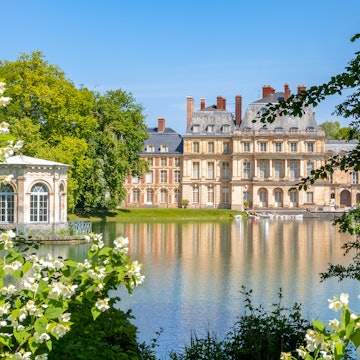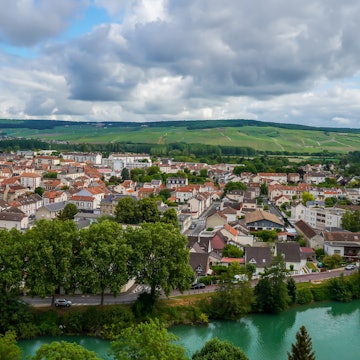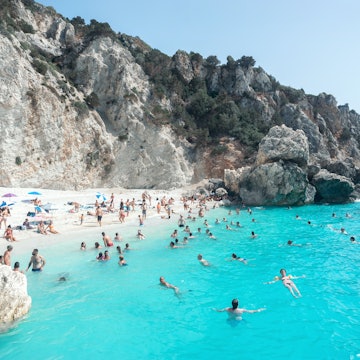

Nantes, France. Getty Images/Hemis.fr RM
Despite being one of the largest urban areas in France, the western city of Nantes is often passed up in favor of better-known – and more classically beautiful – destinations in the region. Although this gritty city certainly isn’t as postcard-ready as its coastal neighbor to the south, Bordeaux, it’s just as worthy of a visit—and not just if you’re a fan of its most famous son, legendary author Jules Verne. Here you can wander through lanes lined with street art, immerse yourself in the fantastical at converted art spaces, or simply enjoy the simple pleasures of cycling, walking and even boating around town. And while Nantes is often seen through the lens of its industrial and maritime past, scratch beneath the surface and you’ll see that despite first impressions, Loire and Breton history and culture is all around you, from the turrets of the landmark Château des Ducs de Bretagne to the Muscadet vineyards that lie mere miles from the city center.

When should I go to Nantes?
Late spring and early fall are ideal for a Nantes visit, with generally pleasant weather without the summer crowds, but it’s best to pack a rain jacket, just in case. Summertime in Nantes brings with it warm, dry weather, but visitor numbers soar, especially in August when it feels like most of France goes on vacation. Still, it may be worth braving the crowds to attend the annual Voyage à Nantes celebration of the arts, a citywide event that brings a packed schedule of performances and art installations to town. In August, music fans from across France and beyond descend on Nantes and 14 other cities in the region for Les Rendez-vous de l’Erdre, one of the largest jazz fests in the country.
How much time should I spend in Nantes?
While you can tick off a few of Nantes’ highlights in one day, it’s better to give yourself a full weekend to get the most out of the city. With a couple of days, you’ll have ample time to check out the steampunk mechanical animalia at Les Machines de l’Île, check out the art and ephemera at the at the Château des Ducs de Bretagne and have a bit of time left over to browse the shops at the Passage Pommeraye or the exhibits at the Musée Jules Verne, dedicated to Nantes’ most famous former resident. With an extra day or two, make Nantes a base for day-tripping to nearby châteaux and Muscadet wineries in the Loire Valley or to history-rich destinations in Brittany and Normandy, such as St-Malo and the Abbaye du Mont-Saint-Michel.
Is it easy to get in and around Nantes?
Getting to Nantes is easy, as is getting around town. Fly straight to the Nantes Atlantique Airport (NTE), about a 20-minute shuttle ride from the city center, or take a high-speed (TGV) train straight from Paris to the heart of the city in about two hours. Public transportation in Nantes is excellent, consisting of three tramlines, an extensive bus network with around 50 lines, along with Navibus shuttle boats, which ply the Loire and Erdre Rivers. Public transportation (with the exception of the airport shuttle) is free on weekends. Nantes is also extremely easy to navigate by bike, with flat terrain and a huge network of bike trails (and plenty of bike racks). While you can rent bikes at shops around town (or borrow them from some hotels), the Naolib bike-sharing system makes it easy to pick up a cycle on the go.

Top things to do in Nantes
Climb Aboard a Steampunk Elephant at Les Machines de l’Île
Drawing inspiration from the "Invented Worlds" of Jules Verne and the mechanical sketches of Leonardo da Vinci, this whimsical theme park of sorts is one of the city’s best-known highlights. Situated on the site of an old shipyard, this magical space invites visitors to check out a gallery full of oversized mechanical creatures, see artisans in action at an open-air workshop and take a ride on a three-story carousel filled with creatures found in different parts of the sea. The star attraction is the Grand Elephant, a four-story mechanical pachyderm that ambles around the park, carrying up to 50 people on board at a time.
Take a Boat Ride on the Erdre River
Nantes is very much defined by its waterways, including the main channel through town – the Loire River – and the Erdre, a tributary that runs through the northern part of the city. Guided boat tours take you up the river and back down again, with guides on board to tell you all about the city's natural and cultural history. If you prefer to explore on your own, and happen to be in town between April and November, rent a kayak or an electric boat (no license necessary) and choose your own floating adventure.

Learn about Nantes through the ages at the Château des Ducs de Bretagne
Constructed in the late 15th century, this sprawling castle – which served as the official residence of the Dukes of Brittany for many centuries — is both an architectural marvel and home to the Nantes History Museum. While you can wander its grassy grounds for free, it’s worth stopping at the museum to check out its 32 rooms of temporary and permanent exhibits, many enhanced by multimedia displays. After visiting the museum, it’s walk over to the Mémorial de l’Abolition de l’Esclavage (Memorial to the Abolition of Slavery), about 20 minutes away on foot, to learn about Nantes' history as France’s principal port in the Transatlantic slave trade.
Stop and smell the flowers at the Jardin des Plantes
Spread across 17 acres, the Jardin des Plantes is a wonderful place for a stroll, even if you aren’t a plant nerd. Here you’ll find centuries-old trees from around the world, 19th-century greenhouses and a resident herd of dwarf goats. The gardens are home to roughly 10,000 species of flora (including a remarkable 600 varieties of camelia). Staff gardeners plant around 50,000 flowers every season, so it feels like there’s always something in bloom.
My favorite thing to do in Nantes.
One of my favorite spots in Nantes is the Île de Versailles, an artificial island in the middle of the Erdre River. Despite its name, this little isle lacks the gaudy gold embellishments of the Château de Versailles near Paris. Instead, the aesthetic is that of a Japanese garden, complete with carefully manicured plants, rock gardens, koi ponds, waterfall features and a trio of structures that seem more suited to Nippon than Nantes. It’s a positively peaceful place for a picnic or a quiet stroll.

How much money do I need for Nantes?
While Nantes isn’t the least expensive city in France, it does offer better value than some of the country’s larger cities, especially Paris. You can easily eat on the cheap if you rely on supermarkets and bakeries for the majority of your meals, though there are plenty of splurge-worthy spots if you’re in the mood for a treat. While credit cards are widely accepted, it can be handy to have a few euros at the ready for small purchases.
Glass of Muscadet wine 5 euros
Espresso at a terrace cafe €3
Plain croissant €1 (
Lunch for one at a mid-range restaurant €15–20
One-hour public transit ticket €2.50
Night in a centrally located hotel: from €90
What should I pack for a trip to Nantes?
Nantes gets plenty of rainfall, and even if you visit during the dry summer, it’s wise to carry a waterproof jacket or an umbrella, as well as some layers for chillier days. Comfortable shoes are a must for exploring the city on foot. While Nantes is a tad more casual than some of France’s bigger cities, it’s still a good idea to pack at least one business-casual outfit if you plan to go out for dinner.
Save money with the Pass Nantes
One of the best ways to keep costs to a minimum is by booking a Pass Nantes, available in increments of 24, 48, and 72 hours, as well as 7 days. These passes include unlimited rides on public transportation (including the airport shuttle) as well as access to many of the city's top attractions, including the Château des Ducs de Bretagne and the Machines de l'île. Guided tours, river cruises and bike and kayak rentals are also included. Passes are available online and in person at the Voyage à Nantes visitor center on the rue des États.
















